Author(s): Gerald C. Hsu
The author uses GH-Method: math-physical medicine (MPM) approach to investigate his risk probability (Risk) of having a cardiovascular disease (CVD) or stroke. Here, the word of CVD implies the most common type of heart diseases
The author uses GH-Method: math-physical medicine (MPM) approach to investigate his risk probability (Risk) of having a cardiovascular disease (CVD) or stroke. Here, the word of CVD implies the most common type of heart diseases. It is also called coronary artery disease (CAD), or coronary heart disease (CHD). All of these situations relate to plaque buildups to block the blood flow in arteries due to high glucose and high lipid, or rupture of arteries caused by high glucose and high blood pressure. Based on the research findings of his CVD and stroke risks investigation, this article specifically addresses how he “reversed” his chronic diseases induced heart conditions in a quantitative manner, via a stringent lifestyle management program without drugs or surgeries [1]. The word “reverse” used in this context is to change the direction of his heart condition’s progression in order to prevent the condition from worsening.
The author is a 73-year-old male who has a history of three severe chronic diseases for over 25 years. He experienced five cardiac episodes, without having a stroke, from 1994 through 2008. During that period, he thought the cause of his cardiac episodes were outcomes from his stressful business life. In mid-2010, he was diagnosed with an acute renal problem with an albumin-tocreatinine ratio (ACR) level of 116 mg/g (30 -300 mg/g refers to albumin excretion above the normal range) and would eventually require dialysis treatment. At that time, he also consulted with three independent physicians and received similar warnings that he would die within 3 to 5 years if he did not reverse his overall poor health conditions. This kidney episode was his final “wake-up call”. Therefore, he launched his own efforts of study and research internal medicine, especially endocrinology. Since 2010, he spent 30,000 hours to focus on research of diabetes and its various complications, especially heart and kidney. Now, he has extended his research into diabetic retinopathy and hyperthyroidism.
During 2010-2013, he self-studied diabetes and food nutrition via reading many textbooks and medical publications. In 2012, he developed a customized computer software to collect vital data of his own health conditions. By 2014, he further developed a complex mathematical model of metabolism and also started his stringent lifestyle management program. As a result, his overall health conditions have been noticeably improving since 2014. In the same year, he decided to gradually reduce the dosage of his three different diabetes medications. By December 8th of 2015, he completely stopped taking all kinds of diabetes medications. Within 2015-2016, he also created four mathematical prediction models for body weight, fasting plasma glucose (FPG), postprandial plasma glucose (PPG), and HbA1C values, and achieved accuracy rates above 97%. Due to his high-tech background, he also applied optical physics and artificial intelligence to develop an iPhone APP to estimate the carbs/sugar amount contained inside of his food from meal photo, and then predicted his finger-piercing PPG level at two hours after first bite of his meal. During the entire postmedication period of 12/8/2015 through 5/5/2020, his lab-tested HbA1C average value is around 6.6% which decreased from his peak value of 10% in 2010.
Arteries in our body carry glucose (nutrition) and oxygen via blood flow to our heart and other organs which then provide energy (i.e. metabolism) for living our life. This situation is remarkably similar to the tubes that transmit gasoline and air to the engine and other parts of the car which provide energy to move the car.
In his various research subjects of diabetes and complications, including heart (CVD, CAD, CHD), stroke, kidney, bladder, nervous system, foot, eyes, and thyroid, he has identified high glucose (diabetes) as the “principal criminal” while high blood pressure (hypertension) and high lipid (hyperlipidemia) are “accessory criminals” that work together to cause various diabetes complications. Glucose contributes somewhere near 40% to 60% weight of the total influences.
There are many contributing factors to high glucose in spite of two biological factors which are pancreatic beta cells damage and being overweight (obesity). In total, there are 24 influentialfactors, such as food, exercise, weather temperature, sleep, stress, etc. Among those many influential factors, the most prominent two are carbs/sugar intake (39%) and post-meal exercise (41%). Exercise not only reduces inflammation in our body organs but also highly effective to bring down our glucose level quickly. The “post-meal” exercise impacts PPG even more obviously. Although some human psychological behaviors, including love to eat and lazy on exercise, are quite common for most people, diet control is indeed far more complicated than exercising in terms of scope of knowledge, variety of choices, and degree of difficulty
Once diet and exercise are in place, most likely, glucose and HbA1C will be under well control. Now, let us expand the glucose control to combine with the management of both blood pressure (reduce salt consumption, avoid stress, exercise) and lipid (avoid fat, reduce cholesterol consumption, exercise), your blood system (both artery and micro-vessels) will then be in a healthy state. This will definitely reduce our risks of having artery problems, such as CVD & stroke; and micro-vessel & nerves problems, such as renal failure, bladder infection, foot ulcer, diabetic retinopathy, and erectile dysfunction, and so forth.
The author has been practicing the following listed rules in terms of his diet nutrition control:
The above section of “Methods” is mainly described in a qualitative manner; however this section of “Results” will be described in a quantitative manner. All of these results are measured and analyzed from data collected during the period of 12/8/2015 through 5/5/2020, the so called his “post- medications period”. Weight Control (Figure 2)
He maintains an 82% of his normal food portion as guidelines of his regular meal amount. In this way, he could maintain his BMI around 25 and his weight would fluctuate between 170 lbs. to 176 lbs. (77.2 kg to 80 kg) with an average weight of 173 lbs. (78.6 kg). As a reference, he weighed 220 lbs. (100 kg) in 2000 and weighted 198 lbs. (90 kg) in 2010.
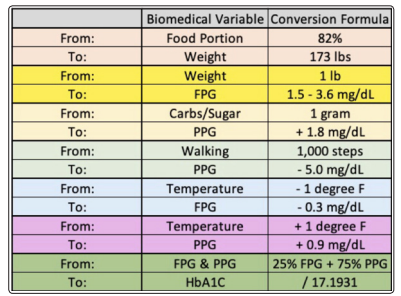
Figure 1: Table of Conversion formulas
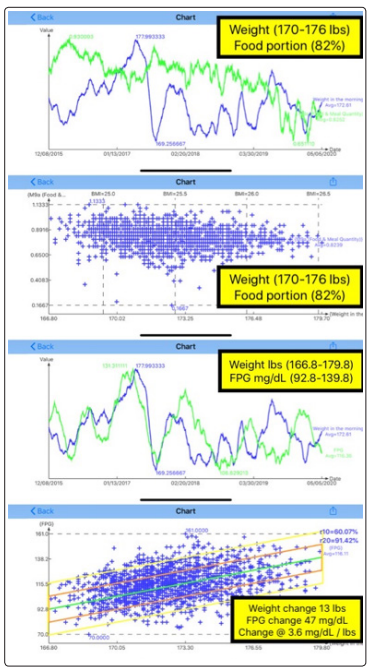
FPG would drop between 1.5 mg/dL and 3.6 mg/dL for each pound of weight reduction. The daily FPG variance range also depends on some other factors, such as sleep condition, stress, cold weathertemperature, etc. During this period of research data, the variance range of his FPG is bouncing between 93 mg/dL and 140 mg/dL with an average FPG of 116 mg/dL.
PPG would increase 1.8 mg/dL for each gram of carb/sugar intake. During this period, his average carbs/sugar intake was 14.48 grams and his average PPG increased by 26.1 mg/dL.
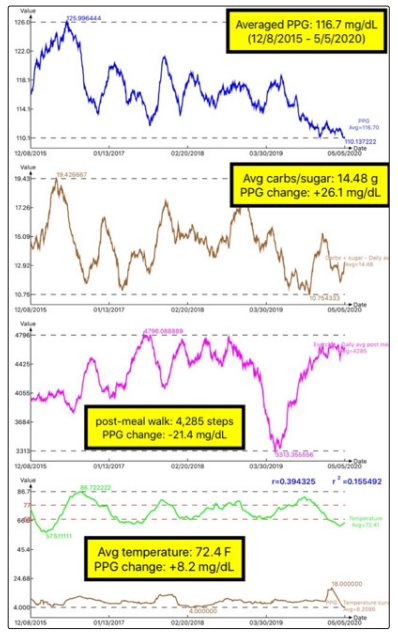
Figure 3: PPG and carbs/sugar, post-meal walking, & temperature
PPG would decrease 5.0 mg/dL for each 1,000 steps of post-meal
walking. During this period, his average post-meal walking was
4,285 steps and his average PPG decreased by 21.4 mg/dL.
FPG would decrease 0.3 mg/dL for every degree Fahrenheit
weather temperature decrease, while PPG would increase 0.9
mg/dL for every degree Fahrenheit weather temperature increase.
During this period, the weather temperatures vary between 58
degree to 87 degree with an average temperature of 72.4 degree.
Most of the time, he moved around according to the change of
weather, except for trips to attend various medical conferences.
As a result, his PPG increased amount from weather temperature
influence is +3.4 mg/dL.
The author utilized signal processing technique to decompose seven waveforms of secondary influential factors and then combined with waves of both carbs/sugar and post-meal walking to obtain a predicted finger PPG at 117.6 mg/dL (Figure 8). This gives a prediction accuracy of 99.2% in comparison with the actual measured finger PPG at 116.7 mg/dL.
FPG occupies ~25% of influential weight on HbA1C formation while PPG occupies ~75% of influential weight on HbA1C formation. During this period, his average FPG was 116.4 mg/ dL while his average PPG was 116.7 mg/dL. They are amazingly close to each other. This is not coincidence, but rather due to his diligence and persistence on implementing his lifestyle management program. As a result, his mathematically predicted daily HbA1C value was 6.8% (97% prediction accuracy) while his 23 collected lab-tested HbA1C average value was 6.6%
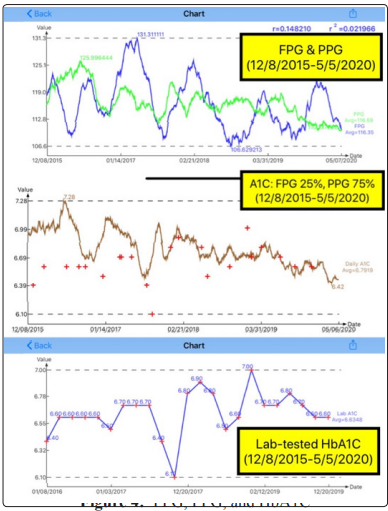
Blood Pressure, Lipid (Figure 5)
His average SBP/DBP/Heart Rate was 109/66/56. His average
Triglycerides/LDL/HDL was 108/109/47. All of these values
are normal and healthy.
His average MI was 0.58 which is extremely healthy (below the break-even line of 0.735, see Reference 1). By implementing and following his stringent lifestyle management program, he could completely control his Type 2 Diabetes conditions. As an associated consequence, his hypertension (high blood pressure) and hyperlipidemia (high lipid) conditions were also well undercontrolled since those three areas are inter-related [2].
In 2017, he developed a sophisticated and complex mathematical model to calculate his risk probability of having a chronic diseases induced CVD or stroke. This model includes personal & genetic data, such as age, gender, race, family medical history, personal health history, BMI (weight & height), waistline, bad habits (smoking, alcohol drinking, illicit drugs), probability of blockage and rupture of blood vessels due to different medical conditions (mainly chronic diseases), and lifestyle details. Here is his annualized risks probability based on MI of having a CVD or stroke (see Figure 3):
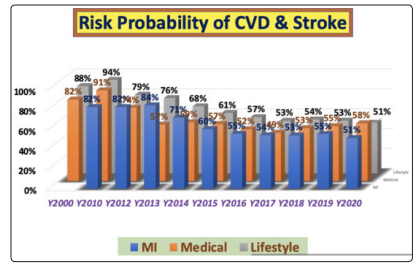
Figure 6: CVD Risk (2010-2020)
Y2000: 85% (weight 220 lbs., BMI 32.5, waistline 44 inches)
Y2010: 82% (weight 198 lbs., BMI 29.2, glucose 280 mg/dL)
Y2012: 82% (glucose 128 mg/dL)
Y2013: 84% (glucose 133 mg/dL)
Y2014: 71% (developed metabolism model, glucose 135 mg/dL)
Y2015: 60% (weight & FPG control, glucose 129 mg/dL)
Y2016: 55% (PPG control & stopped medication, glucose 119
mg/dL)
Y2017: 54% (BMI 25, glucose 117 mg/dL)
Y2018: 53% (heavy traveling, glucose 116 mg/dL)
Y2019: 55% (heavy traveling, glucose 114mg/dL)
Y2020 : 51% (weight 171 lbs., BMI 25, waistline 32.5 in, glucose
112 mg/dL)
It should be noted here that the risk probability percentages are
expressed on a “relative” scale, not on an “absolute” scale.
Due to his heavy traveling schedules of attending more than 60
medical conferences during 2018-2019, his risks of having a CVD
or stroke were in the range of 53%-55%; however, during this
recent stabilized self-quarantined life in 2020 (since 1/19/2020)
has actually helped him to bring his risk down to 51%.
It is quite obvious that his chronic diseases induced CVD risks
and annual average glucoses have an extremely high correlation
of 83% (Figure 7). As he mentioned earlier, through his research
results of the past 5-years, he has already detected that glucose is
the “principal criminal” plus the help from both blood pressure
and lipids as the “accessory criminals” in terms of chronic diseases
induced CVD. Not only his overall health conditions have been
greatly improved which can be seen from his regular medical
examination reports, but also his “reversed” heart conditions
can also be observed from his past medical examination reports.
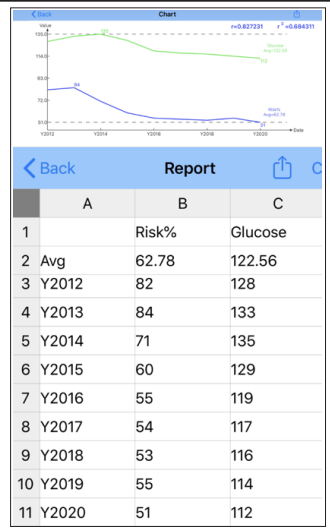
Figure 7: CVD Risks and Glucoses
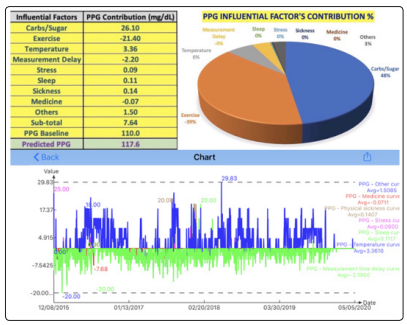
Figure 8: Secondary influential factors of predicted finger PPG via signal processing
Lifestyle change and its continuous management provide better results than medications and/or surgeries. Stents and angioplasties are indeed limited in their functionality. Of course, medications and surgeries can also save patient’s lives; however, they can coexist with a lifestyle management program. It should be further noted that about 5% of the total patients account for up to 80% of the total healthcare costs with heart disease as being number one.
This article describes the author’s cookbook of reversing his CVD conditions via lifestyle management. His CVD risk probability research results for the past 10-years and his lifestyle management related “cookbook of qualitative guidelines and quantitative formulas” from his past 4.5 years work have provided a detailedexplanations of his proven ways to reverse his heart conditions. Human organs are amazing. They have their own memories and strengths to repair themselves if properly taken care of [3].
